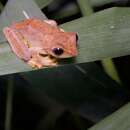Description
provided by AmphibiaWeb articles
M 31-33 mm. F 45-51 mm. A small frog with a broad head and a short pointed snout with sharp edges. All toes are webbed to the base of the discs (except for the fourth toe). The two outer fingers are fully webbed to the discs. Smooth skin on head and back; granular skin on chest and stomach. Colour varies from light grey-green to sandy brown. Some species have dark crossbars on the back and white spots on the side of the head or body. Sides of the body and inner surfaces of the legs are typically bright yellow with several big black spots. Chest and stomach are pearly white (Inger and Stuebing 2005).Tadpoles: Body is oval and slightly flattened above. Slender tail is twice the size of the body. Wide lips form a cup-like structure. Body is dark and almost black on top and sides. Tail muscle mottled with dark spots; upper fin with smaller dark spots. Total length reaches 36 mm (Inger and Stuebing 2005).
Inger, R., Stuebing, R., Iskandar, D., and Mumpuni (2004). Rhacophorus angulirostris. In: IUCN 2008. 2008 IUCN Red List of Threatened Species. www.iucnredlist.org. Downloaded on 06 May 2009.
Distribution and Habitat
provided by AmphibiaWeb articles
This species is known from northern Borneo (Malaysia) and from one locality in Sumatra, Indonesia. It has been observed at an altitudinal range of 700-1800 m asl (Inger et al. 2004). It occurs in primary forest and can be found along clear, rocky streams. Tadpoles live in gravel riffles (Inger and Stuebing 2005).
Life History, Abundance, Activity, and Special Behaviors
provided by AmphibiaWeb articles
The call sounds like a sharp chirp (Inger and Stuebing 2005).
Life History, Abundance, Activity, and Special Behaviors
provided by AmphibiaWeb articles
Habitat loss as a result of clear-cutting is the major threat to this species, and logging has already severely damaged the habitat at one known locality, Mount Trus Madi, in Borneo. Besides Gunung Kinabalu National Park, it is also present in the Crocker Range, in Malaysian Borneo; however, the Sumatran locality lies outside any protected areas (Inger et al. 2004).
Leptomantis angulirostris
provided by wikipedia EN
Leptomantis angulirostris, commonly known as the masked tree frog, is a member of the tree frog family Rhacophoridae and is found in Indonesia and Malaysian Borneo. Its natural habitats are subtropical or tropical moist lowland forests, subtropical or tropical moist montane forests, and rivers. It is threatened by habitat loss.
Description
A relatively small frog, males range in length from 31–33 mm and females from 45–51 mm. The head is wider than long. Snout pointed with sharp canthus rostralis. Dilated finger and toe tips are characteristic. Webbing in feet almost complete, touching the toe pad on all digits except fourth. Webbing in hand partial with webbing reaching the second sub-articular tubercle on finger three. Skin smooth on dorsum, granulated on chest and venter. Variable in skin coloration but broadly ranges from pale grey-green to brown. Dark crossbars are common on dorsum near the vent and on legs. Sides of the body and inner surface of the legs are yellow with black blotches. Often, few fawn colored blotches are found on snout. Iris brown, often with a tinge of blue.[1]
Distribution, natural history and ecology
This species is thought be found in Sumatra and Malaysian Borneo. However, the record from Sumatra warrants scrutiny.[2] It is commonly found in the Crocker Range and Mt. Kinabalu National Park.
It is found in primary rainforests along rocky streams above 1000 m above sea level. Males vocalize perched on small saplings and trees overhanging streams. Tadpoles are known to live in shallow areas of stream underneath gravel.[1][2]
References

- license
- cc-by-sa-3.0
- copyright
- Wikipedia authors and editors
Leptomantis angulirostris: Brief Summary
provided by wikipedia EN
Leptomantis angulirostris, commonly known as the masked tree frog, is a member of the tree frog family Rhacophoridae and is found in Indonesia and Malaysian Borneo. Its natural habitats are subtropical or tropical moist lowland forests, subtropical or tropical moist montane forests, and rivers. It is threatened by habitat loss.
- license
- cc-by-sa-3.0
- copyright
- Wikipedia authors and editors

